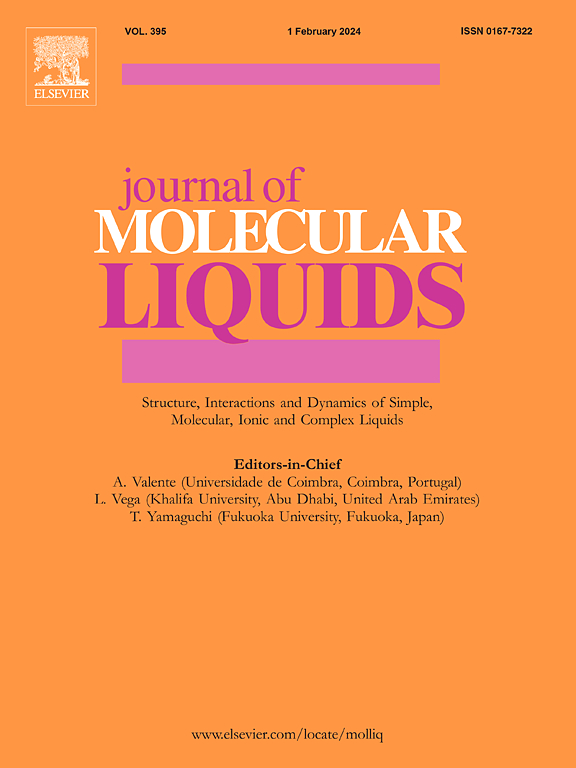Structural transformation and drug delivery in transdermal patches based on ionic liquid-based microemulsion
IF 5.3
2区 化学
Q2 CHEMISTRY, PHYSICAL
引用次数: 0
Abstract
Ionic liquids (ILs) have been extensively studied as part of transdermal drug delivery systems. However, the integration of IL-based formulations into pressure-sensitive adhesives (PSA) remains largely unexplored. In this report, we investigate an IL-in-oil (IL/O) microemulsion-based adhesive transdermal patch (ILP), with a focus on structural transition. Initially, four IL/O microemulsions with different concentrations of IL and surface-active IL (SAIL) were prepared and three (IL/O 1, IL/O 2, and IL/O 4) were chosen based on their particle size (<100 nm). The selected IL/O microemulsions were then blended with PSA (DURO-TAK 87-4098) at an equal ratio and dried at either 25 °C or 60 °C to form ILP1, ILP2, and ILP4. Small-angle X-ray scattering (SAXS) results demonstrated that incorporation of IL/O into the adhesive induced a structural transition, forming a liquid crystal-like lamellar structure with d spacings of 5.44–6.21 nm. Both IL/O composition and drying temperature play an active role in the intensity and peak positions of the SAXS profiles of ILPs. In vitro skin penetration study revealed that all ILPs significantly increased skin penetration compared to control patch. ILP2 achieved the highest acyclovir permeation (3.20 μg/cm2), outperforming ILP1 (2.03 μg/cm2) and ILP4 (1.85 μg/cm2). These findings highlight the significant role of ILP composition in modulating structural transitions and enhancing drug delivery performance, offering valuable insight into the design of IL-based adhesive transdermal patches.

基于离子液体微乳液的透皮贴剂结构转化与给药
离子液体作为经皮给药系统的一部分已经得到了广泛的研究。然而,将il为基础的配方整合到压敏胶(PSA)中仍未得到广泛探索。在这篇报道中,我们研究了一种基于IL- In -oil (IL/O)微乳基的粘接透皮贴剂(ILP),重点研究了其结构转变。首先,制备了4种不同浓度IL和表面活性IL (SAIL)的IL/O微乳,并根据粒径(100 nm)选择了3种IL/O 1、IL/O 2和IL/O 4。将选择的IL/O微乳液与PSA (DURO-TAK 87-4098)以相同的比例混合,并在25°C或60°C下干燥,形成ILP1, ILP2和ILP4。小角x射线散射(SAXS)结果表明,IL/O的加入引起了结构转变,形成了间距为5.44 ~ 6.21 nm的液晶状片层结构。IL/O组成和干燥温度对ILPs的SAXS谱的强度和峰位都有积极的影响。体外皮肤渗透研究显示,与对照贴片相比,所有ILPs均显著增加皮肤渗透。ILP2对阿昔洛韦的渗透性最高(3.20 μg/cm2),优于ILP1 (2.03 μg/cm2)和ILP4 (1.85 μg/cm2)。这些发现强调了ILP成分在调节结构转变和增强药物传递性能方面的重要作用,为基于il的粘附透皮贴剂的设计提供了有价值的见解。
本文章由计算机程序翻译,如有差异,请以英文原文为准。
求助全文
约1分钟内获得全文
求助全文
来源期刊

Journal of Molecular Liquids
化学-物理:原子、分子和化学物理
CiteScore
10.30
自引率
16.70%
发文量
2597
审稿时长
78 days
期刊介绍:
The journal includes papers in the following areas:
– Simple organic liquids and mixtures
– Ionic liquids
– Surfactant solutions (including micelles and vesicles) and liquid interfaces
– Colloidal solutions and nanoparticles
– Thermotropic and lyotropic liquid crystals
– Ferrofluids
– Water, aqueous solutions and other hydrogen-bonded liquids
– Lubricants, polymer solutions and melts
– Molten metals and salts
– Phase transitions and critical phenomena in liquids and confined fluids
– Self assembly in complex liquids.– Biomolecules in solution
The emphasis is on the molecular (or microscopic) understanding of particular liquids or liquid systems, especially concerning structure, dynamics and intermolecular forces. The experimental techniques used may include:
– Conventional spectroscopy (mid-IR and far-IR, Raman, NMR, etc.)
– Non-linear optics and time resolved spectroscopy (psec, fsec, asec, ISRS, etc.)
– Light scattering (Rayleigh, Brillouin, PCS, etc.)
– Dielectric relaxation
– X-ray and neutron scattering and diffraction.
Experimental studies, computer simulations (MD or MC) and analytical theory will be considered for publication; papers just reporting experimental results that do not contribute to the understanding of the fundamentals of molecular and ionic liquids will not be accepted. Only papers of a non-routine nature and advancing the field will be considered for publication.
 求助内容:
求助内容: 应助结果提醒方式:
应助结果提醒方式:


